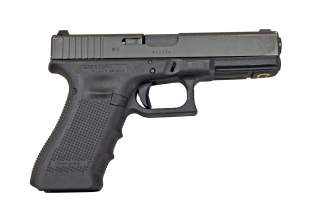Glock 17 vs. Kel-Tec KMR-30: Battle of the High Capacity Pistols
Which is best?
The modern pistol, a handgun fed by a grip-inserted magazine, was a creation of the early twentieth century. Despite the innovation the pistol rarely held significantly more ammunition than a revolver, making revolvers and their superior reliability a viable choice for decades. The advent of the two-column staggered magazine doubled, tripled, and even quintupled the pistol’s magazine capacity. Two modern examples are the Glock 17 and Kel-Tec KMR-30.
The invention of the pistol box magazine promised to vastly increase handgun ammunition capacity. For much of the nineteenth century handgun designs were dominated by the revolver, which stored ammunition in a five or six round revolving cylinder. This was easy to manufacture and used a well known operating system but had its own limitations. Increasing ammunition capacity beyond six rounds increased the diameter of the cylinder and made the pistol wider overall. Making the cylinder larger also made the revolver heavier and more unwieldy.
The box magazine promised to to change things. The box magazine could be inserted into the pistol grip, with the cartridges sitting in a narrow vertical column. The Colt M1911 handgun could carry seven .45 ACP rounds in a magazine. That wasn’t appreciably better than a revolver, however. The solution? Stack ammunition in two vertical columns that merged at the top, allowing the same amount of ammunition to fit in the same space.
Recommended: Air War: Stealth F-22 Raptor vs. F-14 Tomcat (That Iran Still Flies)
Recommended: A New Report Reveals Why There Won't Be Any 'New' F-22 Raptors
Recommended: How an ‘Old’ F-15 Might Kill Russia’s New Stealth Fighter
The use of polymers in handguns started in the late 1970s and was popularized with the Glock 17 handgun. The Glock’s frame and grip are made of plastic, while the barrel and slide are made from steel. This reduces weight appreciably. The weight reduction, coupled with a double stack magazine, allowed the Glock to boost its ammunition capacity to 17 rounds of nine millimeter parabellum ammunition.
Glock built a high capacity handgun, but one designed to be a service handgun for the Austrian Army. The Glock 17 balances weight versus ammunition capacity versus ammunition lethality in ways other handguns had not, gaming the system by using lightweight materials other handguns had not. The resulting handgun was a reliable, accurate handgun just 8.03 inches long. It packed seventeen rounds of nine millimeter Luger ammunition in a magazine well less than five inches long. The Glock weighs just 25.02 ounces unloaded and 32.12 ounces fully loaded.
Another handgun, the Kel-Tec KMR-30, took a slightly different path. Like the Glock 17 the KMR-30 is made of steel and polymer to save weight. Kel-Tec’s use of polymer in pursuit of weight savings was more radical: although roughly similar to the Glock and other polymer pistols the KMR-30 goes a step further and uses polymer in a large portion of the slide.
Although durable the Kel-Tec was not designed as a military or law enforcement service weapon, allowing the company to make some unconventional choices. Kel-Tec’s minimalist approach to pistol design also strips away material where it isn’t needed, and the use of the low-recoil .22 Magnum round means fewer places where steel is needed for strength. As a result, the Kel-Tec weighs a remarkable 13.6 ounces unloaded. Fully loaded with 30 rounds of ammunition, the KMR-30 still weighs just 19 ounces.
How did Kel-Tec achieve M16-size ammunition storage in the KMR-30? By using smaller diameter bullets. The Glock 17 was engineered to kill or incapacitate human beings, and uses the larger nine millimeter luger. The Kel-Tec, although also a self-defense weapon, was also designed as a backcountry plinker or target pistol and uses less lethal (and smaller diameter) .22 Magnum ammunition.
Both the Kel-Tec and the Glock have generously-sized magazines, but the two are meant for very different tasks and the designers have made very different design choices. What works for the Glock does not work for the Kel-Tec, and vice-versa; the Austrian Army would have never accepted the use of .22 Magnum ammunition, even if it came with a larger magazine, while backcountry travelers counting every ounce might scorn the Glock’s weight. Each lightweight, high capacity handgun occupies fills its own niche, small or large.
Kyle Mizokami is a defense and national security writer based in San Francisco who has appeared in the Diplomat, Foreign Policy, War is Boring and the Daily Beast. In 2009 he cofounded the defense and security blog Japan Security Watch. You can follow him on Twitter: @KyleMizokami.
Image: Wikimedia Commons

